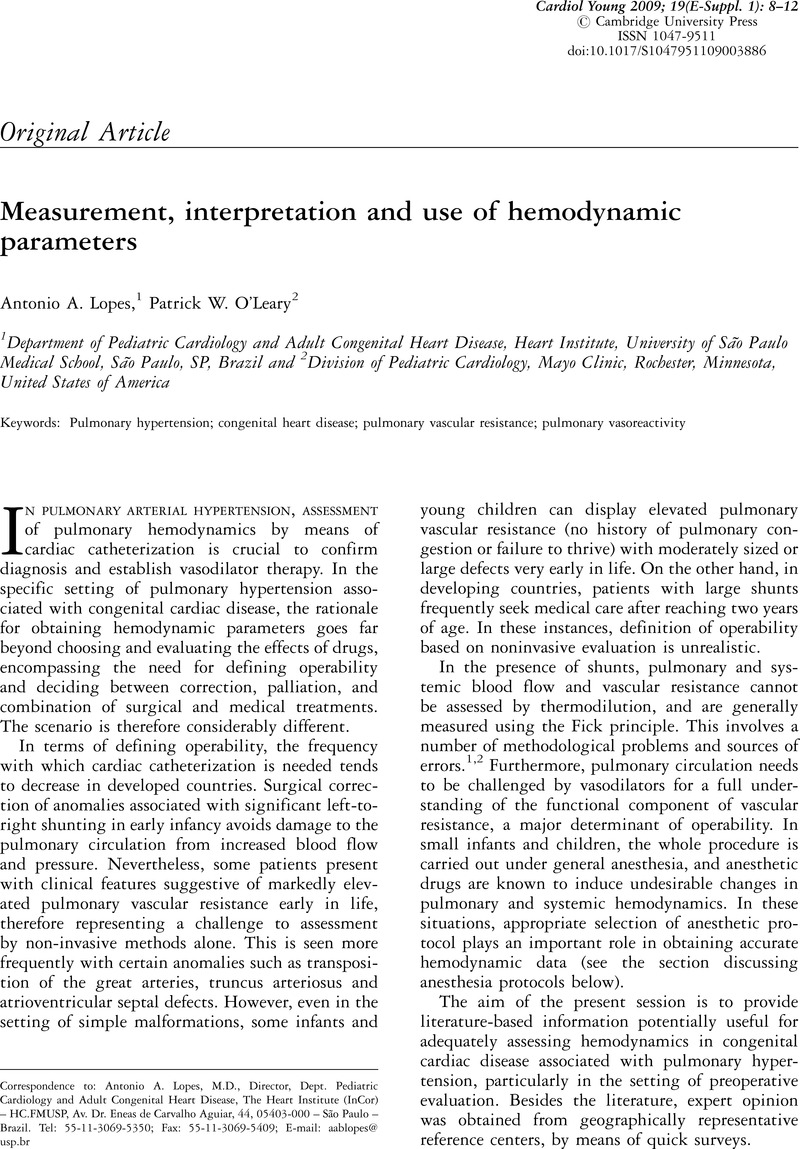Crossref Citations
This article has been cited by the following publications. This list is generated based on data provided by Crossref.
Ajami, Gholam Hossein
Cheriki, Sirous
Amoozgar, Hamid
Borzouee, Mohammad
and
Soltani, Manoucher
2011.
Accuracy of Doppler-Derived Estimation of Pulmonary Vascular Resistance in Congenital Heart Disease: An Index of Operability.
Pediatric Cardiology,
Vol. 32,
Issue. 8,
p.
1168.
Wacker, J.
and
Beghetti, M.
2011.
Complication vasculaire pulmonaire des cardiopathies congénitales.
EMC - Pneumologie,
Vol. 8,
Issue. 2,
p.
1.
Havlík, Jan
Kučerová, Lucie
Kohút, Imrich
Dvořák, Jan
and
Fabián, Vratislav
2012.
Information Technology in Bio- and Medical Informatics.
Vol. 7451,
Issue. ,
p.
169.
Tissot, Cécile
and
Beghetti, Maurice
2012.
Pediatric Cardiovascular Medicine.
p.
730.
Ribeiro, Marcelo Silva
Pereira, Fabricio Leite
Nascimento, Wanda Teixeira do
da Costa, Rodrigo Nieckel
Kreuzig, Daniela Lago
Pedra, Simone Rolim Fernandes Fontes
Elias, Patricia Figueiredo
Pessoti, Cristiane
Jatene, Ieda Bosisio
Silva, Maria Aparecida Paula
Martins, Ricardo Fonseca
Santana, Maria Virginia Tavares
Fontes, Valmir Fernandes
and
Pedra, Carlos Augusto Cardoso
2013.
Feasibility, Safety, and Efficacy of Percutaneous Atrial Septal Defect Closure in Infants.
Revista Brasileira de Cardiologia Invasiva (English Edition),
Vol. 21,
Issue. 2,
p.
165.
Ribeiro, Marcelo Silva
Pereira, Fabricio Leite
Nascimento, Wanda Teixeira do
da Costa, Rodrigo Nieckel
Kreuzig, Daniela Lago
Pedra, Simone Rolim Fernandes Fontes
Elias, Patricia Figueiredo
Pessoti, Cristiane
Jatene, Ieda Bosisio
Silva, Maria Aparecida Paula
Martins, Ricardo Fonseca
Santana, Maria Virginia Tavares
Fontes, Valmir Fernandes
and
Pedra, Carlos Augusto Cardoso
2013.
Feasibility, Safety, and Efficacy of Percutaneous Atrial Septal Defect Closure in Infants.
Revista Brasileira de Cardiologia Invasiva (English Edition),
Vol. 21,
Issue. 2,
p.
165.
Roodpeyma, Shahla
Rafieyian, Sima
and
Sharifi, Seyed Hassan
2014.
Evaluation of Right Ventricular Systolic Function by Echocardiography in Pulmonary Hypertension Associated With Congenital Heart Disease: a Cross Sectional Study.
Razavi International Journal of Medicine,
Vol. 2,
Issue. 4,
Galiè, Nazzareno
Humbert, Marc
Vachiery, Jean-Luc
Gibbs, Simon
Lang, Irene
Torbicki, Adam
Simonneau, Gérald
Peacock, Andrew
Vonk Noordegraaf, Anton
Beghetti, Maurice
Ghofrani, Ardeschir
Gomez Sanchez, Miguel Angel
Hansmann, Georg
Klepetko, Walter
Lancellotti, Patrizio
Matucci, Marco
McDonagh, Theresa
Pierard, Luc A.
Trindade, Pedro T.
Zompatori, Maurizio
and
Hoeper, Marius
2015.
2015 ESC/ERS Guidelines for the diagnosis and treatment of pulmonary hypertension.
European Respiratory Journal,
Vol. 46,
Issue. 4,
p.
903.
Song, Jinyoung
Huh, June
Lee, Sang-Yun
Kang, I-Seok
Lee, Chang Ha
Lee, Cheul
Yang, Ji-Hyuk
and
Jun, Tae-Gook
2016.
Hemodynamic Follow-Up in Adult Patients with Pulmonary Hypertension Associated with Atrial Septal Defect after Partial Closure.
Yonsei Medical Journal,
Vol. 57,
Issue. 2,
p.
306.
Galiè, Nazzareno
Humbert, Marc
Vachiery, Jean-Luc
Gibbs, Simon
Lang, Irene
Torbicki, Adam
Simonneau, Gérald
Peacock, Andrew
Vonk Noordegraaf, Anton
Beghetti, Maurice
Ghofrani, Ardeschir
Gomez Sanchez, Miguel Angel
Hansmann, Georg
Klepetko, Walter
Lancellotti, Patrizio
Matucci, Marco
McDonagh, Theresa
Pierard, Luc A.
Trindade, Pedro T.
Zompatori, Maurizio
and
Hoeper, Marius
2016.
2015 ESC/ERS Guidelines for the diagnosis and treatment of pulmonary hypertension.
European Heart Journal,
Vol. 37,
Issue. 1,
p.
67.
Manes, Alessandra
2017.
Pulmonary Hypertension in Adult Congenital Heart Disease.
p.
45.
Huang, Wei-Chun
Hsu, Chih-Hsin
Sung, Shih-Hsien
Ho, Wan-Jing
Chu, Chun-Yuan
Chang, Chih-Ping
Chiu, Yu-Wei
Wu, Chun-Hsien
Chang, Wei-Ting
Lin, Lin
Lin, Shoa-Lin
Cheng, Chin-Chang
Wu, Yih-Jer
Wu, Shu-Hao
Hsieh, Tsu-Yi
Hsu, Hsao-Hsun
Fu, Morgan
Dai, Zen-Kong
Kuo, Ping-Hung
Hwang, Juey-Jen
and
Cheng, Shu-Meng
2019.
2018 TSOC guideline focused update on diagnosis and treatment of pulmonary arterial hypertension.
Journal of the Formosan Medical Association,
Vol. 118,
Issue. 12,
p.
1584.
Arvind, Balaji
Relan, Jay
and
Kothari, Shyam S.
2020.
“Treat and repair” strategy for shunt lesions: a critical review.
Pulmonary Circulation,
Vol. 10,
Issue. 2,
p.
1.
Brida, Margarita
Nashat, Heba
and
Gatzoulis, Michael A.
2020.
Pulmonary arterial hypertension: closing the gap in congenital heart disease.
Current Opinion in Pulmonary Medicine,
Vol. 26,
Issue. 5,
p.
422.
Wang, Jou-Kou
Chiu, Shuen-Nan
Lin, Ming-Tai
Chen, Chun-An
Lu, Chun-Wei
and
Wu, Mei-Hwan
2021.
Transcatheter Closure of Atrial Septal Defect Associated With Pulmonary Artery Hypertension using Fenestrated Devices.
The American Journal of Cardiology,
Vol. 147,
Issue. ,
p.
122.
Barradas-Pires, Ana
Constantine, Andrew
and
Dimopoulos, Konstantinos
2021.
Preventing disease progression in Eisenmenger syndrome.
Expert Review of Cardiovascular Therapy,
Vol. 19,
Issue. 6,
p.
501.
Jone, Pei-Ni
Ivy, D. Dunbar
Hauck, Amanda
Karamlou, Tara
Truong, Uyen
Coleman, Ryan D.
Sandoval, Juan Pablo
del Cerro Marín, María Jesús
Eghtesady, Pirooz
Tillman, Kathryn
and
Krishnan, Usha S.
2023.
Pulmonary Hypertension in Congenital Heart Disease: A Scientific Statement From the American Heart Association.
Circulation: Heart Failure,
Vol. 16,
Issue. 7,
Liao, Ke
Elibol, Armagan
Gao, Ziyan
Meng, Lingzhong
and
Chong, Nak Young
2025.
Predicting hemodynamic parameters based on arterial blood pressure waveform using self-supervised learning and fine-tuning.
Applied Intelligence,
Vol. 55,
Issue. 6,



